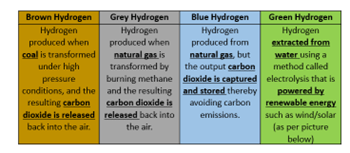Environment & Ecology, Governance
Context: The Union Cabinet, chaired by the Prime Minister has approved India’s Rs 20,000 cr National Green Hydrogen Mission (NGHM).
About Hydrogen:
- Hydrogen is the chemical element with the symbol H and atomic number 1.
- Hydrogen is the lightest element and the most abundant chemical substance in the universe, constituting roughly 75% of all normal matter.
- It is colourless, odourless, tasteless, non-toxic, and highly combustible.
- Hydrogen fuel is a zero-emission fuel burned with oxygen. It can be used in fuel cells or internal combustion engines and as a fuel for spacecraft propulsion.

Extraction of Hydrogen:
- Hydrogen exists in combination with other elements.
- Hence, for using it as a source of energy, it has to be extracted from naturally occurring compounds like water (which is a combination of two hydrogen atoms and one oxygen atom).
- The sources and processes by which hydrogen is derived are categorised by different colours.
Benefits of Green Hydrogen
- Creation of export opportunities for Green Hydrogen and its derivatives
- Decarbonisation of industrial, mobility and energy sectors
- Self-Reliance: Reduction in dependence on imported fossil fuels and feedstock
- Make in India, for India: Development of indigenous manufacturing capabilities
- Creation of employment opportunities
- Development of cutting-edge technologies
Major Challenges in harnessing Green Hydrogen:
- Lack of fuel station infrastructure: India will need to compete with around 500 operational hydrogen stations in the world today which are mostly in Europe, followed by Japan and South Korea.
- Energy-intensive nature of Hydrogen generation process:
- The technology is in an infant stage and the energy requirement for splitting water or Methane is high. Besides, the whole process is costly at present.
- High R and D requirement for the newer technology for making the process cheap and operational and scalable.
- Multiplicity of regulatory authorities: Involvement of multiple Ministries and Departments causes red tape in government functioning.
- Risks associated with the transportation of hydrogen: Hydrogen in gaseous form is highly inflammable and difficult to transport, thereby making safety a primary concern.
About National Green Hydrogen Mission (NHM):
- NGHM is a part of National Hydrogen Mission (NHM) which was announced by the finance minister in the Union Budget 2021-22.
- The Prime Minister of India also announced the National Hydrogen Mission on India’s 75th Independence Day.
- The Ministry of New and Renewable Energy (MNRE) will formulate the scheme guidelines for implementation of the respective components.
Objectives of the mission:
- To make India a global hub for the production and export of green hydrogen.
- To harness green hydrogen energy to fulfill India’s Nationally Determined Contributions (NDCs).
Key Components of the mission:
- The NGHM will facilitate demand creation, production, utilization and export of Green Hydrogen.
- The Mission will also support pilot projects in emerging end-use sectors and production pathways.
- An enabling policy framework will be developed to support establishment of the Green Hydrogen ecosystem.
- A public-private partnership framework for R&D will be facilitated under the Mission. R&D projects will be goal-oriented, time bound, and suitably scaled up to develop globally competitive technologies.
Significance of the NGHM:
- Renewable Energy Capacity Enhancement: Development of green hydrogen production capacity of at least 5 MMT (Million Metric Tonne) per annum.
- An associated renewable energy capacity addition of about 125 GW in the country
- It will boost Investment opportunities for India and create sustainable employment.
- Cumulative reduction in fossil fuel imports.
- Green House Gas Emission Reduction: Abatement of nearly 50 MMT of annual greenhouse gas emissions and help government in achievement the commitments made at COP 26.
Initiatives taken by the world countries and India:
- Japan: Basic Hydrogen Strategy 2017 and plan to develop the international hydrogen supply chain by 2030.
- South Korea: Hydrogen Economy Development and Safe Management of Hydrogen Act, 2020.
- The Ministry of Road Transport and Highways (MoRTH) issued a notification proposing amendments to the Central Motor Vehicles Rules, 1989 with safety evaluation standards for hydrogen fuel cell-based vehicles.
- Delhi State Government: Hydrogen Spiked Compressed Natural Gas Buses (H-CNG) i.e. 18% blend of hydrogen with CNG (Plan to have 80% H-CNG buses by 2025)
- NTPC Ltd is operating a pilot to run 10 hydrogen fuel cell-based electric buses and fuel cell electric cars in Leh and Delhi.
Way Forward:
The National Hydrogen Mission have the capability of ensuring integration of India’s clean energy supply chains with that of the world when Inter-Ministerial and various departments work together.
The National Hydrogen Mission will also will ensure realization of the goal of making India carbon neutral and global hub of clean hydrogen energy and will have multiplier effects on the $5 trillion economy.
Source: Indian Express













